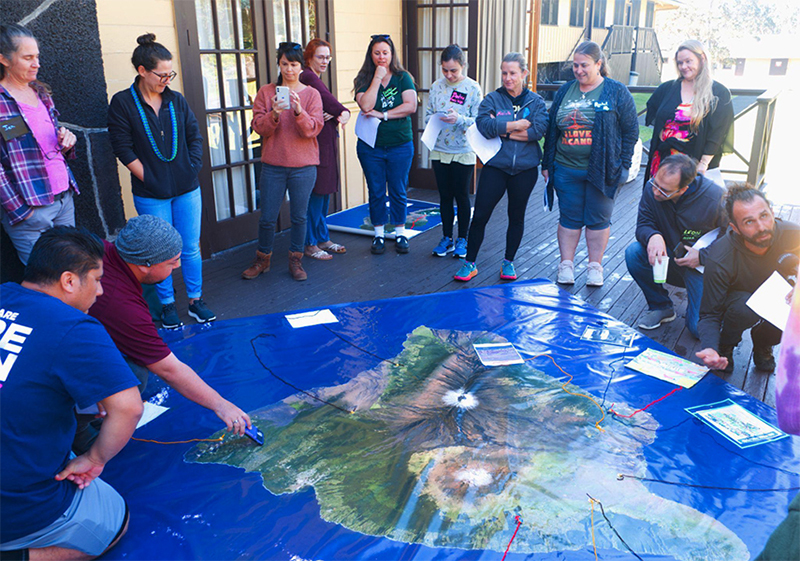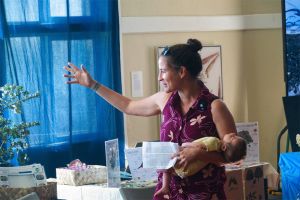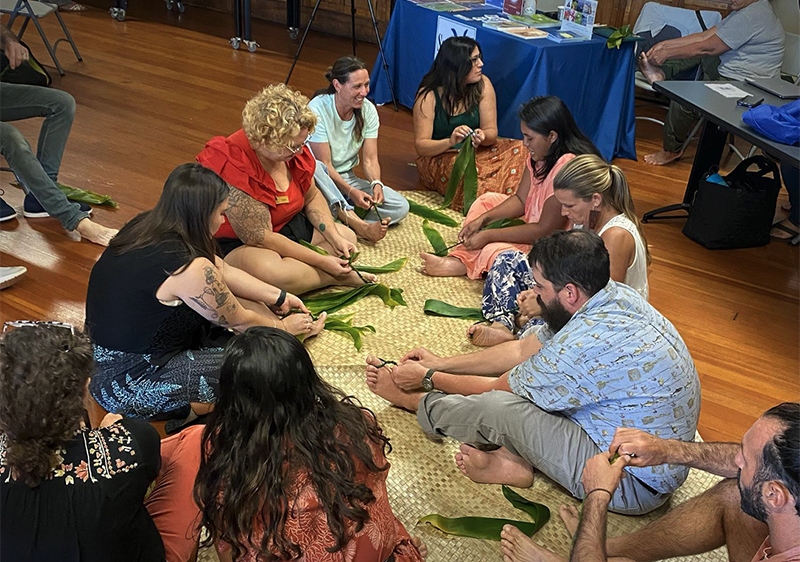Fostering collaboration: Insights from the recent Earth to Sky workshop for Hawaiʻi climate science educators

In January, two dynamic cohorts totaling 42 educators from Oʻahu, Maui, Molokaʻi, and Hawaiʻi convened for Earth to Sky, a transformative three-day climate communication course. This immersive workshop aimed to equip educators with tools to craft engaging, place-based learning experiences rooted in the latest climate science research and Hawaiʻi’s unique cultural and environmental heritage.
Hosted at the Daniel K. Inouye Regional Center on Oʻahu and the Hawaiʻi Volcanoes National Park and Mokupāpapa Discovery Center on Hawaiʻi Island, participants, including both informal and formal educators, immersed themselves in seminars, field trips, demonstrations, and collaborative working groups. The event, held in collaboration with the Pacific Island Climate Adaptation Science Center (PI-CASC), National Aeronautics and Space Administration (NASA), National Oceanic and Atmospheric Administration (NOAA), National Marine Sanctuaries Foundation, National Park Service (NPS), University of Hawaiʻi Sea Grant College Program, and the Hawaiʻi Department of Education, fostered rich dialogue and cross-pollination of ideas.
A central goal of Earth to Sky was to cultivate ‘pilina’—relationships—among Hawai’i’s climate science educators. Beth Lenz, PI-CASC’s diversity specialist and graduate scholar program coordinator, highlighted the importance of breaking down silos in education. To facilitate ongoing collaboration, participants were encouraged to join What Schools Could Be, an online community of practice offering resource-sharing and engagement on climate science research specific to Hawaiʻi.

The research found in a 2024 NOAA Notice of Federal Funding underscores the impact of professional development on educators’ ability to integrate climate science into their student learning activities. By showing educators new ways to ground learning experiences in place, educators are better equipped to inspire students to engage with environmental issues. During the workshop, Leila Dudley, Pilina ʻĀina program coordinator, emphasized the significance of connecting science to place and Hawaiʻi lifeways to the educators in attendance.
“Our foundational program was Teaching Change,” Dudley later explained in email correspondence after the event. Dudley described the deep meaning and purpose students felt when climate science was connected to Hawaiʻi lifeway. “Connecting scientific research to Hawaiʻi lifeways includes teaching students to care for ‘āina (land), literally translated to “that which feeds you,” as though it was a family member by raising awareness of environmental threats to Hawaiian Island ecosystems and engaging in ways to reduce those effects through restoration work,” said Dudley.
As educators have more opportunities to participate in learning at events like Earth to Sky, climate science can be better integrated into lesson plans, empowering students to foster a deeper connection to their environment.
Upon completion of Earth to Sky, educators departed with a wealth of regional climate science data and resources, community connections, and practical frameworks for curriculum, grants, and lesson plan development. With these resources, climate science educators are better poised to cultivate the next generation of environmental stewards.

Hawaiʻi-based educators are encouraged to join the What Schools Could Be online platform to collaborate, access resources, and stay informed of Hawaiʻi climate science research. Simply register and find the “collaboration” called “Hawai‘i Climate Change Hui” to join!

